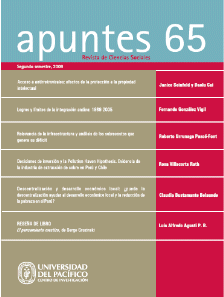Investment decisions and Pollution Hipotheses Haven. Evidence of copper mining industry in Peru and Chile
DOI:
https://doi.org/10.21678/apuntes.65.592Abstract
This essay asks whether or not environmental legislation is one of the most important factors defining investment decisions in the copper mining industry, or if other factors are more important for decision-makers in those companies. Considering the relative importance of environmental legislation factors in the decision-making process, whether or not differences in environmental legislation between Peru and Chile have led to the migration of companies of one country to the other, phenomenon known as the Pollution Haven Hypothesis (PHH), is then analyzed. A survey was employed; both hypotheses were rejected. The fact that Peru has lower Maximum Allowed Limits (MAL) than Chile and that companies operating in the latter country have more voluntary certifications than the ones operating in Peru suggests the existence of PHH. Nevertheless, the claim that countries prefer to invest in Peru rather than in Chile because of the lower standards is not supported because almost the same Transnational Companies (TNCs) invest in both. In order to confirm the existence or not of a Pollution Haven (PH) in any of these countries, other factors such as the proportion of overall costs occupied by environmental regulation and the evolution of emissions should be assessed in further studies.Downloads
Download data is not yet available.
Downloads
Published
2009-03-10
How to Cite
Villacorta Rath, R. (2009). Investment decisions and Pollution Hipotheses Haven. Evidence of copper mining industry in Peru and Chile. Apuntes. Social Sciences Journal, (65), 95–146. https://doi.org/10.21678/apuntes.65.592
Issue
Section
Articles
License
Apuntes publishes all its articles and reviews under a Creative Commons Attribution (CC BY 4.0) license with the objective of promoting academic exchange worldwide. Therefore, articles and book reviews can be distributed, edited, amended, etc., as the author sees fit. The only condition is that the name of the author(s) and Apuntes. Revista de Ciencias Sociales (as the publisher) be cited.



.jpg)
